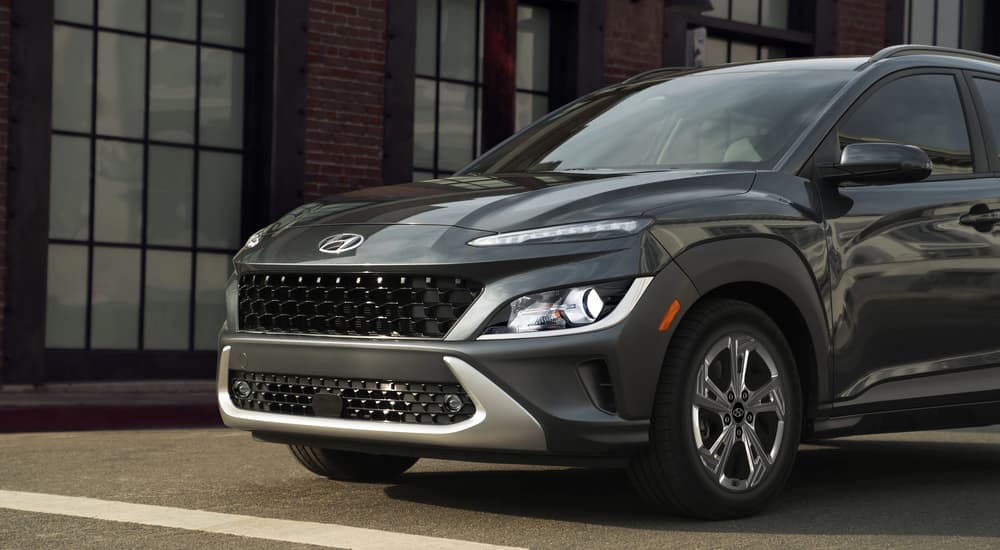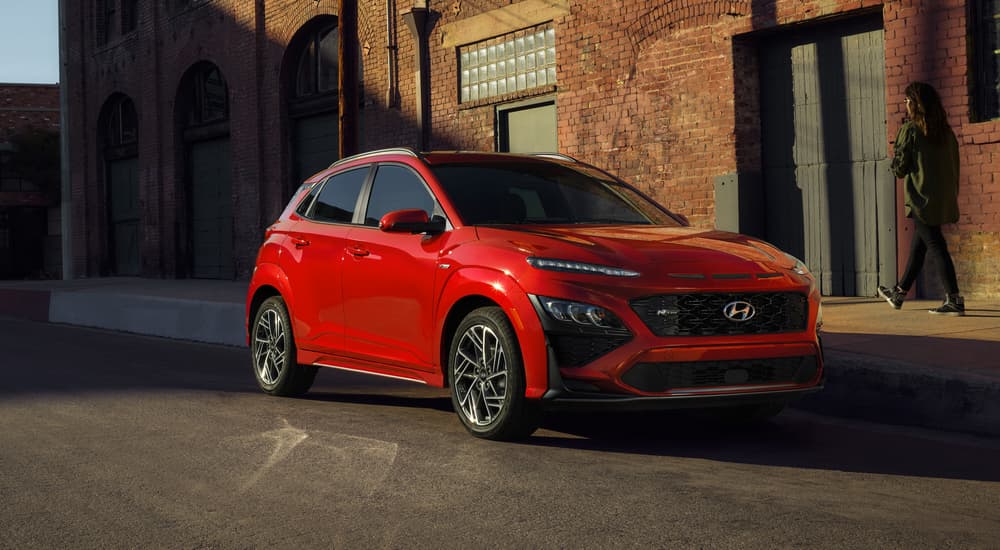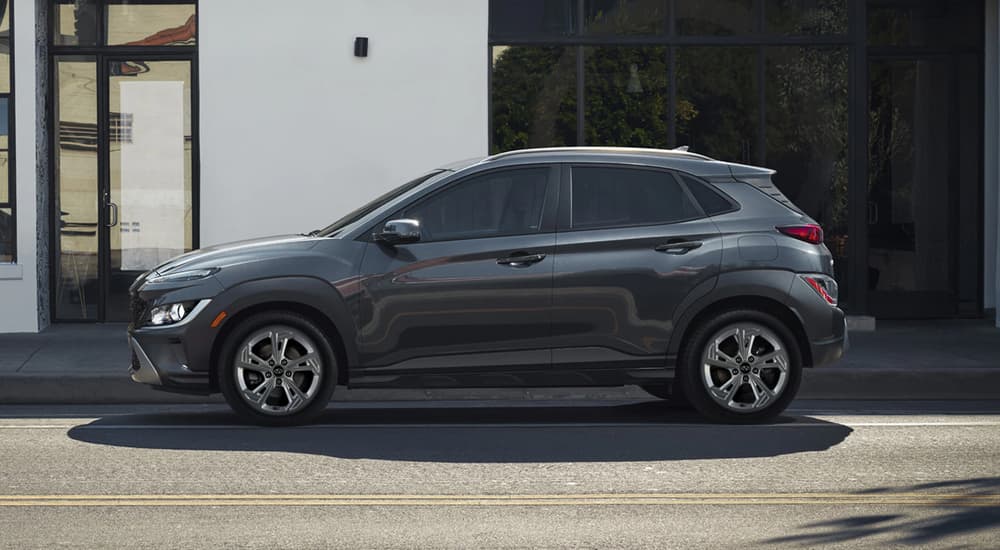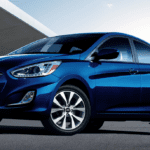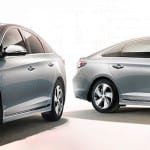If you’re the kind of person that likes to do their research before buying a vehicle, you might have a number of questions about what a certain model is like or how it measures up in its segment. You might wonder about the price, availability, trim selection, and how it stacks up to its nearest competitors. If you are researching the Hyundai Kona, in particular, you will find it is one SUV that isn’t always in the spotlight but still manages to stay on the lips of potential shoppers.
Whether shopping for a new or used Hyundai Kona for sale, you will likely wonder about certain aspects of the Kona, especially if you’re not too familiar with it. What does a Hyundai Kona compare to? What makes it better or worse than its nearest competitors? Well, the Kona finds itself in the small SUV category, and it is often compared to other small SUVs such as the Chevy Trax, the Honda HR-V, the Mazda CX-30, the Buick Encore, and the Kia Seltos. But why is that, and how does the Kona compare to the competition?
Why Is the Hyundai Kona Classified as a Small SUV?
The designation of vehicle sizes in Canada is determined by the Natural Resources of Canada’s (NRCan) EnerGuide system. This organization outlines the fuel economy ratings, which are determined by the size and classification of the vehicles. For instance, you typically wouldn’t compare a Hyundai Kona to a Chevy Suburban. These are two completely different vehicle classes in two completely different categories.
The NRCan has a total of 16 different vehicle classifications, which include everything from two-seaters to pickup trucks. SUVs like the Kona are officially divided into “small” and “standard” categories depending on their curb weight. The Kona tips the scales at between 1,315 kg and 1,509 kg depending on the trim, putting it well under the NRCan’s 2,722 kg limit for “small” SUVs. In fact, it is so small it is often informally referred to as a “subcompact” SUV.
The Kona is commonly compared with other subcompact sport utility vehicles in the same segment, such as the Subaru Crosstrek, Nissan Qashqai, Honda HR-V, Mazda CX-30, and Toyota CH-R. These models all slot in below the somewhat more popular “compact” SUVs like the Toyota RAV4, Honda CR-V, and Nissan Rogue, offering drivers a more affordable and more efficient ride.
How Does the Kona Compare in Fuel Economy?
Whether you’re looking to buy a brand new Kona or scouring through listings for a used Hyundai Kona for sale, one of the most important things most shoppers are looking for is fuel economy ratings. The good news is that the Kona actually has very commendable fuel economy ratings for its segment. Hyundai even offers an electric version of this subcompact SUV that has a range of 415 km, allowing you to leave the gas pump behind entirely.
If you go with the base 2.0L engine, the 2023 Kona can achieve up to 7.4 L/100km with front-wheel drive or 7.9 L/100km with all-wheel drive. Even if you opt for the available turbocharged engine with its 195 hp and standard all-wheel drive, you can enjoy a respectable 8.2 L/100km. For a brief comparison to some other 2023 models, the Subaru Crosstrek gets 7.9 L/100km, and the Nissan Qashqai gets 8.0 L/100km. By that token, the Hyundai Kona definitely nets you better fuel economy by comparison.
How Does the Kona Compare in Safety?
The Hyundai Kona is considered to be an extremely safe small SUV, especially in comparison to other small SUVs, such as the Jeep Renegade or the Buick Encore. Recent model year Hyundai Konas all have excellent ratings from the Insurance Institute for Highway Safety (IIHS). In fact, the Hyundai Kona has been rated very highly for multiple years.
If you compare the Kona to the recent model years of the Honda HR-V, for example, you’ll note that the IIHS actually has better ratings for the Kona from its introduction in 2018 all the way up to the 2022 model year. Across the board, the Kona simply has high marks available in every major category. There has been a consistent measurement of safety for Hyundai’s small SUV over the years.
These safety ratings definitely make the Kona look like a good buy for drivers searching for a used SUV for sale because it holds up over time. Those ratings also stay consistent when buying new, so it’s easy to see how the Kona manages to stay competitive regardless of the model year.
What Is the Kona’s Cargo Space Like?
The cargo capacity of the Hyundai Kona doesn’t put it in the upper echelon compared to some of the other small SUVs on the market. However, it manages to hold its own and offers more cargo capacity than some of its nearest competitors. In fact, the Hyundai Kona has more cargo volume than some of the subcompact models from automakers like Toyota.
The newer Konas have a max cargo volume of up to 1,296 litres with the rear seats folded and up to 544 litres behind the rear seats. By comparison, the Toyota C-HR tops out at a max of 1,031 litres of cargo volume with the rear seats folded. The Hyundai Kona also manages more cargo capacity than the Fiat 500X. While both diminutive SUVs may not sit at the top of the cargo volume hill, the Kona still beats the 500X, which tops out at 400 litres of cargo volume with all seats raised, and 1,127 litres of cargo volume with the rear seats folded.
How Does the Kona Compare in Tech?
The Hyundai Kona compares really well with other small SUVs in the tech department. In fact, when you consider what the Kona compares to in the small SUV segment, it has one of the best infotainment suites available, topping out with a 26 cm HD touchscreen. It also features navigation support, SiriusXM satellite radio, and wireless Apple CarPlay and Android Auto. The Kona even has dynamic voice recognition for vehicle information control, navigation, and hands-free calls and text.
This puts the Hyundai Kona’s infotainment size above what’s available in the Nissan Kicks and Nissan Qashqai, as well the Mazda CX-3 and Mitsubishi RVR. The infotainment size is on par with what you can find in the Kia Seltos and Kia Soul, as well as the higher trims of the Jeep Compass. Like its other segment competitors, the Hyundai Kona has all the basic tech accoutrements you could ask for, including wireless charging, a digital gauge cluster, and remote connectivity so you can access some features from your smartphone app.
The Kona Is a Cut Above
As a small SUV, the Hyundai Kona holds its own rather well across a number of facets when compared to other SUVs in the same segment. Owners probably already recognize how much they enjoy the Kona, but if you are looking to buy a new or used Hyundai Kona for sale, you are likely happy to learn that it compares really well to the competition. In many cases, it actually manages to outdo its competitors rather handily for its price and features, which is always a good thing.
